James Clarkson
Interview by David McLeavy
-
Published October 2018
-
James Clarkson’s works across sculpture, photography and installation. Through a myriad of references from the history of painting, to the trajectory of western design, Clarkson makes assembled and collaged work along with moulded and shaped sculptures to investigate our relationships with objects and the material world.
-
 Various works, laser cut steel, Graphic design, install view, Futura Project, Prague, 2014
Various works, laser cut steel, Graphic design, install view, Futura Project, Prague, 2014You have recently started to make work again after a period of hiatus. I am interested to know if your approach to making work has changed following a break? If so, how could you tell me about some of the ideas around your new work?
I think the hardest part of coming back after a break from my practice was realising I hadn't really stopped working at all. To put this in to context, as most people probably aren't aware, I spent the last couple of years away from making art and during that time founded a clothing company with you. When we were making the clothing we were still very influenced by what was going on in contemporary art and tried hard to push some of those ideas in to what we were making. Engaging in the process of mass-producing an object was also really interesting for me, especially thinking about how an idea could be circulated more widely through and object that wasn’t an artwork.
When returning to making art I began to think about how these experiences could inform my work. I stated to think about how serially manufactured objects are rarely perceived as authentic, yet they retain a sense of originality as an archetype of something we feel the object might represent. A good example is the earliest version of the Citroen Picasso or the seasonal use of International Klein Blue that yo-yos between cat walk and Primark. In each of these examples there is an absent original object and I think the clothing we made together had a sense of nuancing of history like this, but with out such specificity. The work I have been making recently is carrying on this exploration of originality and repetition of ideas through objects, thinking about what they might represent beyond their function.
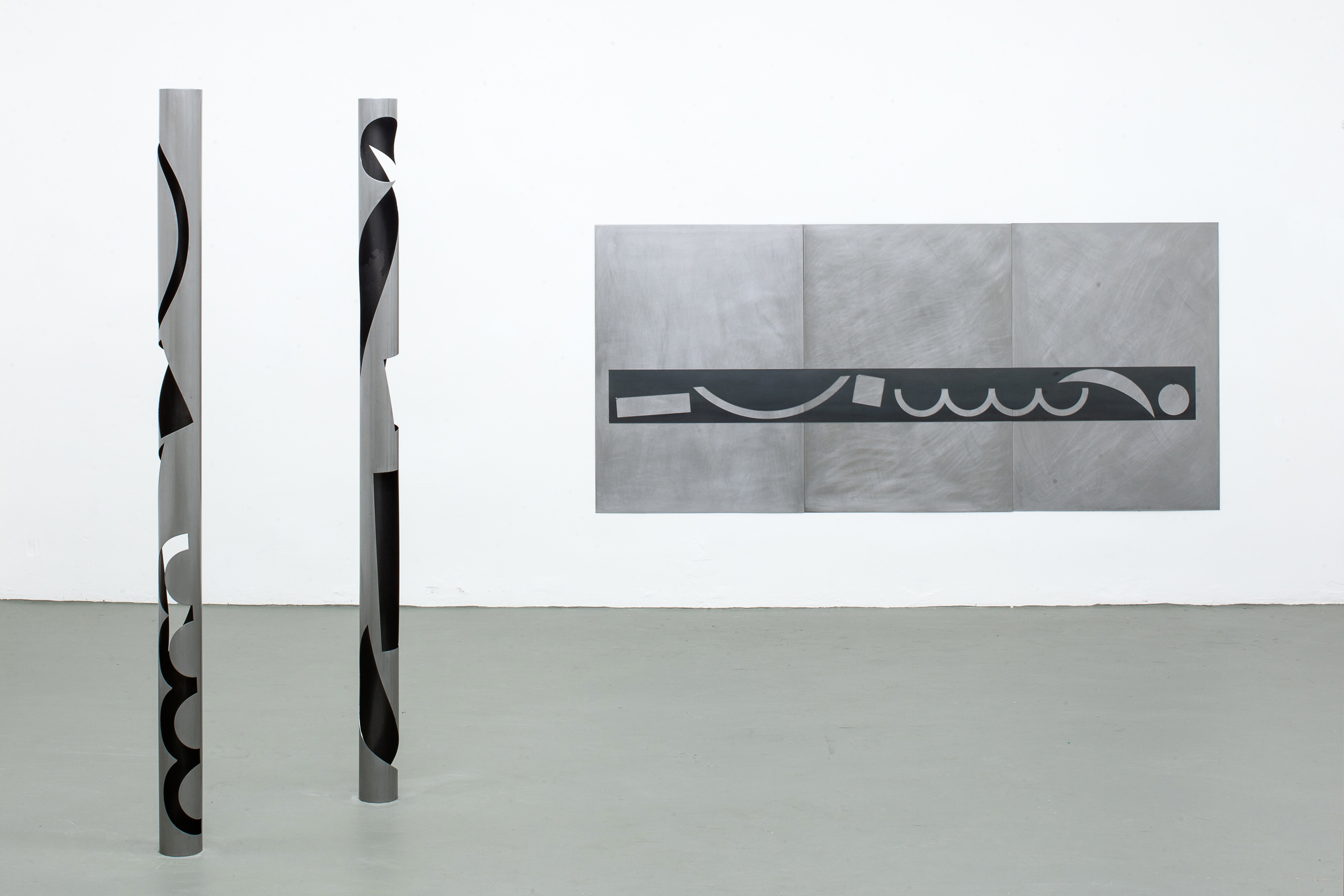 Studio floor composition, laser cut mild steel, Futura Project, Prague, 2014
Studio floor composition, laser cut mild steel, Futura Project, Prague, 2014You mentioned the Citroen Picasso and Yves Klein as recurring references. I was wondering if you felt your projects Pavilion at David Dale Gallery, Glasgow and A Painted Sun as a Yellow Spot at Rod Barton, London, which reference the Citroen and YK quite explicitly, are still as relevant to your work now as they were back in 2012 when you made them?
In some respects they are, perhaps the exhibition at Rod Barton Gallery more so. In both exhibitions I wanted to explore specific elements of each artists work I felt had become a mass produced cultural trope outside of the artwork itself. The Citroen Picasso is interesting because to me cars, in their design, are very sculptural cubists objects, so to name one after Picasso is initially quite funny. But equally to name a car after Picasso is a commercially led, warped approach to the abstraction of the aesthetics and conceptual ideas of his work. Do you need to enjoy Picasso's work to enjoy the car? Probably not, and its the slippages between influence and object, which I really want to explore further.
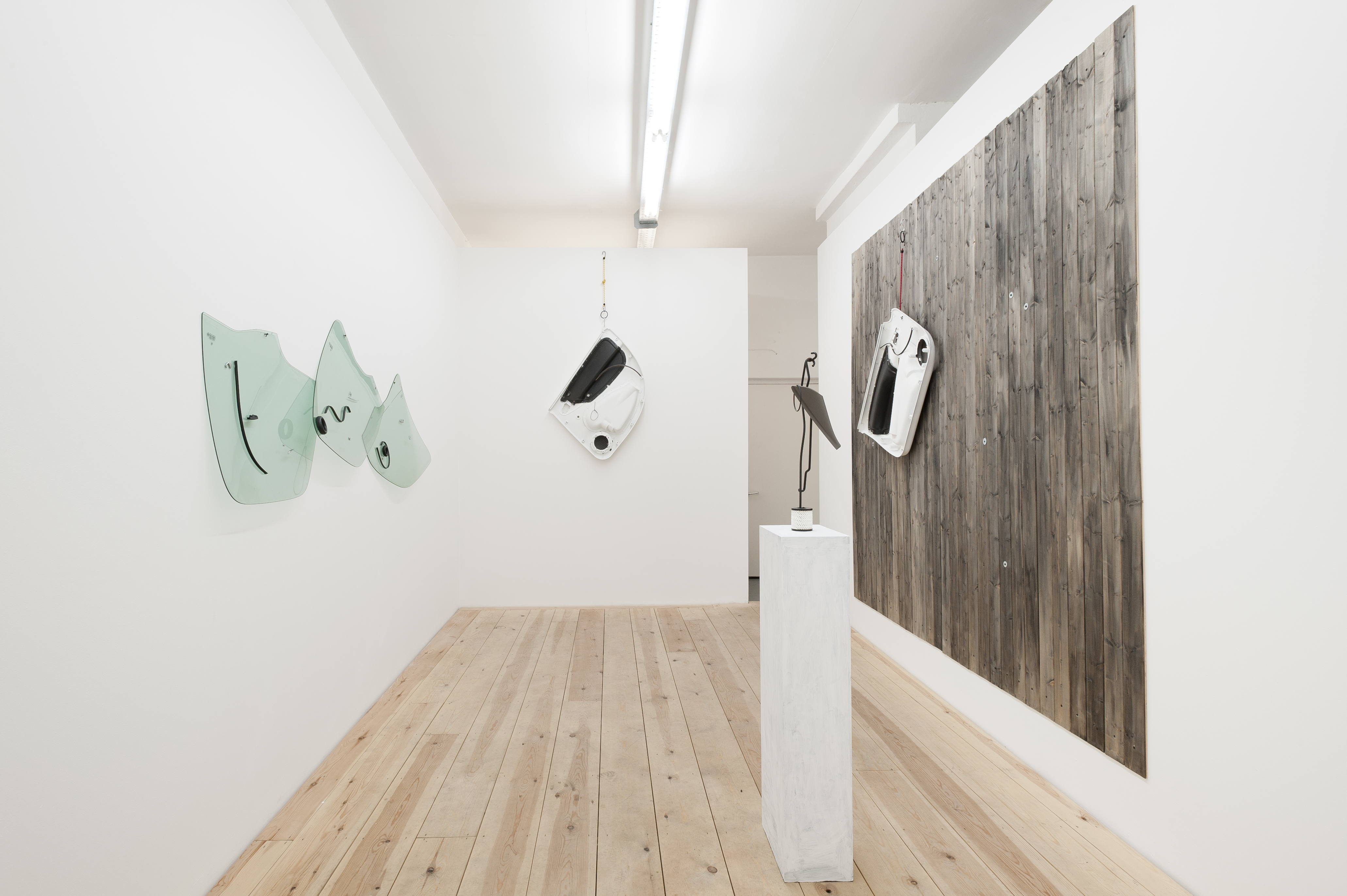 A painted Spot as a Yellow Sun, installation view, citroen picasso parts, Rod Barton, London, UK
A painted Spot as a Yellow Sun, installation view, citroen picasso parts, Rod Barton, London, UKHere is a slightly different question, but I wonder what you feel the role of ‘art’ or the ‘artist’ should be?
I think this is a question without a definitive answer and maybe a better question to ask why should we look at art over any of the other images that frequently populate our lives? As a curator perhaps you have an answer to this?
To answer your question though, the difficulty is that art has no specific purpose and is entirely defined by the person making it, this is what makes art interesting. The role of art should be the freedom to talk about things that no one else is talking about, whether that's to do with the world we live in now, the future or a conversation that ended a long time ago. Art is shining a new light on everything, with no requirement to have a fixed or solid outcome. In recent times I feel like this has been forgotten and the role of art has a lot more requirement to make a change or do something really specific. For me that's not imperative and as I said at the start of this answer these things often come down to the individual making the work.
 Drop Box (series), powder coated laser cut and formed steel, 2018
Drop Box (series), powder coated laser cut and formed steel, 2018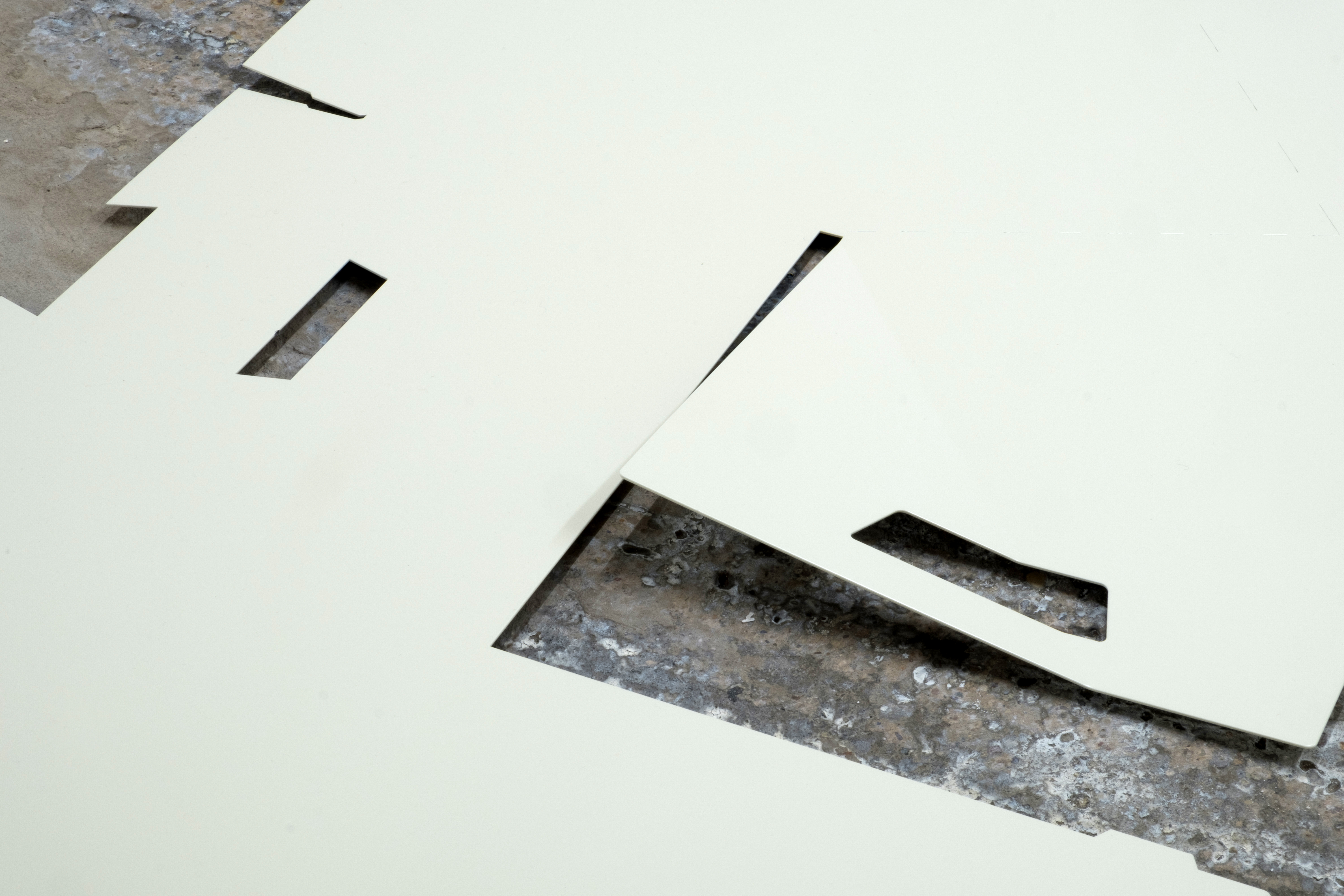 Drop Box (series), powder coated laser cut and formed steel (detail), 2018
Drop Box (series), powder coated laser cut and formed steel (detail), 2018So you are saying that you feel there is an expectation from most people is that art should instigate change, whether that be social, political or some other form, whereas you don’t necessarily believe that this should be the case?
Continuing from this point, I want to know more about your relationship with your audience. Your work often contains some fairly particular points of reference, examples may be certain points in contemporary art and design history, and I want to know if you consider the points of access to your work from the perspective of the viewer?
I don't think it's an expectation from most people, but what I think I was getting at is that there is currently a feeling that art has to make change rather than create the grounds for change. I think what I am nervous about is that trying to strive for these goals invites an idea of an artwork being complete in its attempt to achieve its goals. I feel like art should open things up to let things happen, rather than be so direct. I think almost all art, by its nature of response, is inherently political, in the broadest sense.
In the past the references in my work sometimes might have been too obscure and possibly lacked a point of connection for the viewer. It's been important for me to identify things like this and make my work more digestible for its audience. Currently I am experimenting with re-making a number of pre-existing objects, which when presented might feel entirely familiar to the viewer, without having to have a particular telling of a story behind them. In these works I am trying to create that feeling you get when you sit in a chair somewhere and even though you have never sat in it before there is a sense of something either being entirely familiar or unfamiliar, but often it's not different. If that makes sense?
I am interested in your analogy about sitting in a chair and feeling something familiar. I wonder if you could expand on that a little as I feel there is great depth in the conversations around familiarity, especially when trying to consider the interaction between artwork and public.
Well I think in this case, when you are talking about the viewer, it’s another really difficult question to answer. It’s not a case of just ‘what does the viewer feel that is familiar? But, which viewer? And what knowledge or meaning do they personally bring with them to the gallery? That is the trigger for the work I think, and no one person is right or wrong. To some people it might be the object I am replicating, a simple I get what that is moment, to others they might bring and understanding of the reproduction that is relational to a moment or memory in their life and others might see how I am trying to subvert the object and its place in a very expansive history of objects and our relationship to them.
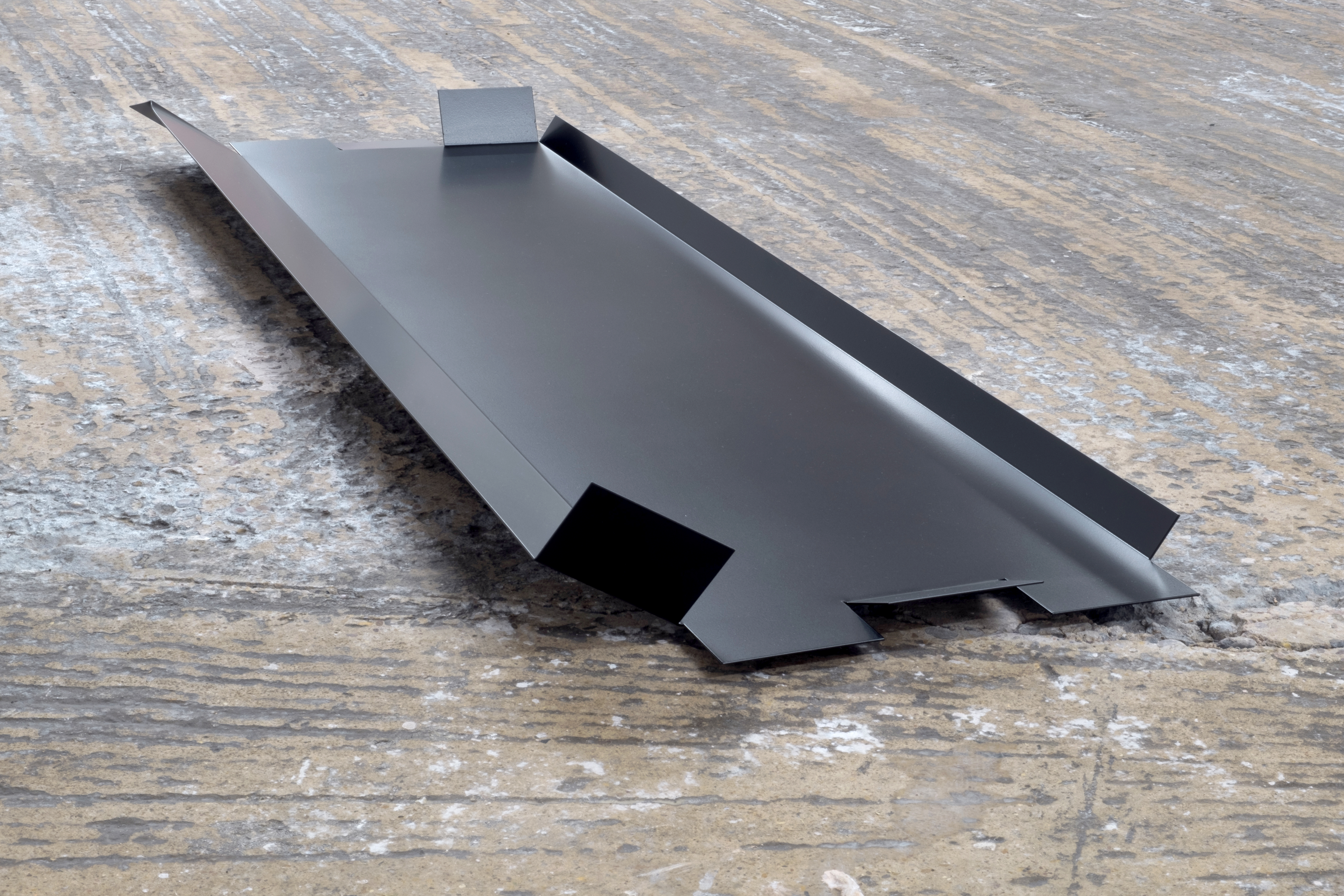 Drop Box (series), powder coated laser cut and formed steel, 2018
Drop Box (series), powder coated laser cut and formed steel, 2018Are you working on anything at the moment that might best exemplify this?
I am currently working on my own version of IKEA’s FNISS bin, using a modern ceramic mass manufacturing process. I kept seeing the IKEA bin in people's homes, office spaces and shops, each time I saw it I was reminded of a vase designed by modernist ceramicist Keith Murray. The vase by Keith Murray is one of the earliest examples of affordable minimalist modern design, which was mass produced for the UK market in the 20’s and 30’s. In my mind aside from their visual likeness both objects are part of the same history, along with a number of other versions of the design that exist before and after these two objects. My version is an attempt to understand how the history of the Keith Murray vase is present and negated at the same time within the design of the IKEA bin. Even if we are not aware of its likeness to anything else, we already accept the IKEA bin as being inauthentic due to its manufacturing process and sales platform. But we are also happy to project originality on to it through our own perceptions of what it might mean to us in a wider cultural system of object representation. I am also interested in how as the manufacturing process was scaled up, for the bin, the original design went from display object to functional item, a vessel for our discarded items.
 Drop Box (series), powder coated laser cut and formed steel, 2018
Drop Box (series), powder coated laser cut and formed steel, 2018I am also currently in the process of making a number of sculptures that replicate nets of unfolded cardboard boxes. The sculptures lay flat on the floor, they are mostly empty, in places their flaps lifted from the floor, as if someone deconstructed the box, took its contents and left. The sculptures present the aftermath of an object that came before, its form is now only suggested by the empty structure of the box. I am interested in exploring how we encounter objects, unboxing something is now often the first time we touch an object after viewing it online and the insane amount of un-boxing videos on Youtube also highlights our obsession/fetish for constant new experiences of objects by peeling back layers of packing.
When laid out the forms of the boxes also start to become intermingled with the history of other objects and artworks. As with the IKEA bin many of the ideas are the same here. The exploration of form within a collective unconscious, an exploration of how when something is presented in a certain way, regardless of knowing all the facts we have been conditioned to perceive it the same.
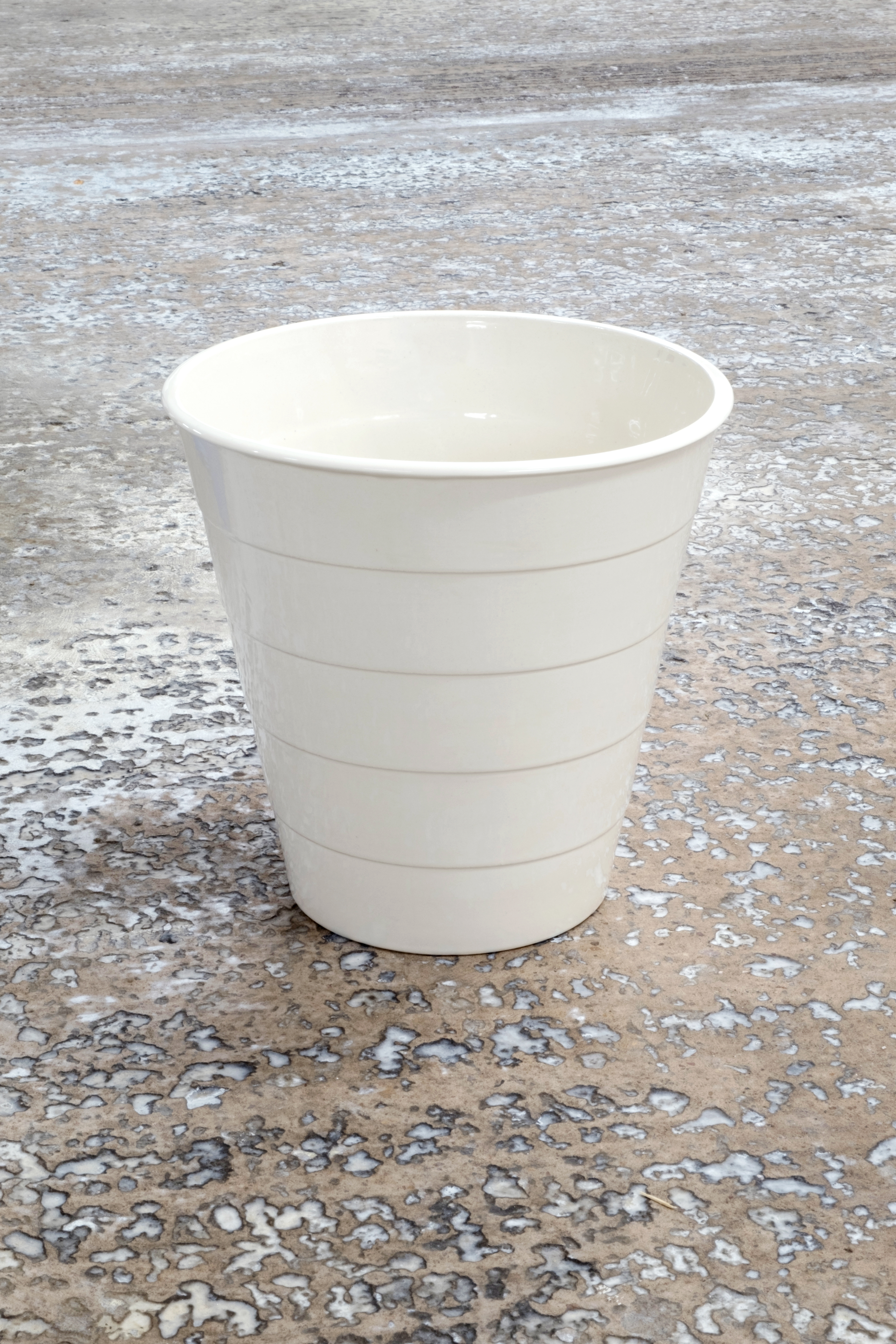 giggle, ceramic slip cast replica of IKEA FNISS bin, 2018
giggle, ceramic slip cast replica of IKEA FNISS bin, 2018I always find it strange visiting IKEA, as on one hand you are fully aware of the scale of the operation, therefore how many people around the world are purchasing the same items for their homes and offices, yet something unique still remains, as if you believe that how you chose to display or use ‘your’ object once leaving the store will be somehow unique. I am also interested in the relationship between the authentic and the mass produced item, an example would be the FROSTA stool from IKEA and how this is one of the most common stools found in homes and offices (also galleries) yet it is based on the Artek Stool 60 by the designer Alvar Aalto, which now retails at a much higher prices as it is a collectable. I wondered if you had anything to add to my musings…
I think Stool 60 is an interesting object in this respect. It originally became available to the public in 1933 and then later when Artek was founded it started to be reproduce it in higher numbers. The stool then became such a significant piece of background design that IKEA and a number of other manufacturers wanted their own version. Interestingly what makes Alvar Aalto’s design so striking is that it has 3 legs. At the time this was a modern take on a more traditional design of this type of stool. To get around copyright IKEA and the other brands made their version with an extra leg and raised the manufacturing numbers again. Thinking about this product timeline, at no point is Stool 60 truly original and as it becomes more manufactured it becomes more desirable as a contemporary and antique object. IKEA are very good at piggy backing off trends and representing things to mass appeal.
To think about IKEA more specifically I feel that it operated like a physical output of an algorithm that knows what you want before you do. Most times I have entered IKEA it has managed to present me with a physical manifestation of some deep inner desire I was yet to act upon. It catches you in that uneasy moment, almost as a surprise and so no matter how many people are having that same experience it still feel personal to you. I think about it as a bubble-like echo chamber, which is working very similar to social media, responding to people's purchasing habits, testing how things work in shop displays which simulate different customers personal tastes. Your experience there seems to be all feedback to this.
Again I think this comes down to a sense of familiarity, where through some vague recollection of everything designed you ever saw this thing/object seems to fit, even though its a stranger. And this is the way I think everything in the world is starting to shape our lives. We feel deep nostalgia and desire for things we barely know. The history of everything doesn’t matter so much anymore because it does not need to be understood in the linear narrative of say Stool 60. I am interested in what that means for everything else.
 Circular motif with two hanging forms, umbrella, bathroom lamp, aluminium, flex, 2014
Circular motif with two hanging forms, umbrella, bathroom lamp, aluminium, flex, 2014I like how you mention that “the history of everything doesn’t matter so much anymore because it does not need to be understood in the linear narrative of say Stool 60”. Does this also relate to taste or fashion in a way? To expand, I am wondering if you feel like tastes, perhaps in the artworld, may seem less easily definable now then perhaps historically, at least within a linear narrative?
Its hard to answer this question with out a time machine. We can quantify historical taste and fashion because both things lead to artworks being recorded. Now everything is recorded and is present everywhere all the time, things float to the top or sink to the bottom. Maybe fashions move quicker and taste can change more quickly, we are more responsive now. We have less time and so does our taste and fashion choices. I think that’s what you were hinting at with your question?
 Upright, rod display system, brass, tea light holder parts, curtain hoop, 2013
Upright, rod display system, brass, tea light holder parts, curtain hoop, 2013-
James Clarkson lives and works in Sheffield. Recent solo exhibitions include Smooth Flow, The Tetley, Leeds, Automatic, Jeanroch Dard, Paris, Twin Tone Lustre, DREI, Cologne, Pavillion, David Dale, Glasgow, Abstracts for a Cascade Garden, Supplement Gallery, London and A Painted Sun as a Yellow Spot, Rod Barton Gallery, London. Recent group exhibitions include About Sculpture #3, Rolando Anselmi, Berlin, Burned by the Sun, Mallorca Landings, Mallorca, I Can’t See Anyone Else in Here Smiling, DREI, Cologne and Wearing Potentiality, Paradise Row, London.
-
james-clarkson.co.uk
-
If you like this why not read our interview with Rosie King
-
© 2013 - 2018 YAC | Young Artists in Conversation ALL RIGHTS RESERVED
